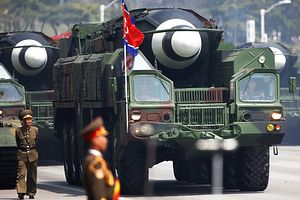On Sunday April 16, North Korea conducted an unsuccessful missile test near its port city of Sinpo. According to U.S. Pacific Command, the medium range missile blew up almost immediately upon launch and its exact model is still as yet unknown. This is Pyongyang’s third unsuccessful missile test in 2017, the previous two taking place in late March and then again on April 5.
Schadenfreude?
While it might be tempting to indulge in some schadenfreude at North Korea’s missile failures and cheer the apparent embarrassment inflicted upon the North’s leadership from having their rocket aggrandizement fall flat on its face, gloating is ill-advised. This is because Pyongyang learns technical lessons from both its successes and failures, and might well decide to test even more missiles or detonate a nuclear device in the very near future, if for no other reason than to save face in front of its international audience while salvaging a domestic propaganda victory.
Regarding technical learning, each missile or nuclear test provides valuable data to the DPRK’s scientists and technicians, enabling them to rectify hardware deficiencies and improve the reliability or efficacy of future missile and warhead prototypes. Hence, the fact that Kim Jong-un is able to marshal the resources required to sustain the nuclear and missile program is fundamentally a baseline victory regardless of any test outcomes.
It can also be argued that governing North Korea involves a fair amount of political theater, both to deter foreign adversaries as well as to bolster domestic morale and confidence in national sustainability. Since the most recent missile test was conducted one day after the 105th anniversary of the birth of the North’s founding leader, Kim Il-sung and was quite probably a birthday tribute to the late Kim, such an occasion requires a successful technological demonstration to fulfill external and internal propaganda imperatives. Consequently, this missile failure is very likely to spur more hasty tests in the days or weeks ahead in the hope that at least one of them can be declared a success. Indeed, there is a historical precedent for this as the DPRK tested two Hwasong-10 Intermediate Range Ballistic Missiles within a single day on June 22, 2016, with only the second missile being an unmitigated success. Moreover, if subsequent missile tests do not yield the required success for politico-nationalistic showboating, the Kim regime might well order its sixth nuclear test, which is definitely more destabilizing.
What next?
Much has been said about how tensions in the region have spiked as the Trump administration has declared that the strategy of “strategic patience” towards the North will be discontinued in favor of more aggressive and punitive measures to enforce the denuclearization of the DPRK, up to and including the employment of military force. This was underscored by Washington’s announcement that a carrier battle group led by the USS Carl Vinson was being deployed to the region. In return, Pyongyang predictably responded with vitriolic rhetoric, declaring that North Korea is “ready for war” with the United States.
In such a volatile environment, it is perhaps commendable that Trump has wisely chosen to withhold comment about the failed missile test. Any taunting official statements or even tweets would have poured salt on Pyongyang’s proverbial wounds and most certainly have exacerbated regional tensions. However, restraint on Washington’s part does not obviate Kim Jong-un’s need to deliver a demonstration of technological achievement and this makes a follow-up missile test appear almost inevitable.
With this in mind, and for the sake of regional conflict management, it might be prudent for Trump to borrow a leaf from the playbook of former President Barack Obama and look to non-military punitive measures or sanctions implemented on a multilateral basis and with Chinese cooperation. For instance, the Brussels-based Society for Worldwide Interbank Financial Telecommunication (SWIFT) has already cut off North Korean banks from its services while Beijing has already halted all coal imports from the DPRK for 2017. Inasmuch as effective sanctions take time for their coercive impact to be truly felt by Pyongyang’s ruling class, they are preferable to the rapid escalation to armed conflict should either the Kim regime or Trump administration should miscalculate and launch a pre-emptive strike.
Lastly, in the event that the next missile test fails and/or Kim decides to authorize the DPRK’s sixth nuclear test, it is worth noting that Trump has publicly committed U.S. policy towards a more muscular and aggressive approach in dealing with Pyongyang’s nuclear proliferation. If he does not follow through on his tough talk of unilaterally solving the North Korean problem, whether by military or other methods, and if Beijing elects not to help, this could significantly undermine Washington’s regional credibility. Accordingly, the prospects for peace and stability in Northeast Asia appear far more precarious than they were during the DPRK’s previous five nuclear tests. Successfully navigating the coming days or weeks will require Pyongyang, the U.S. and Beijing to exercise utmost caution in their decision-making.
Liang Tuang Nah is a Research Fellow of the Military Studies Program, Institute of Defense and Strategic Studies, a constituent unit of the S. Rajaratnam School of International Studies (RSIS), Nanyang Technological University.

































